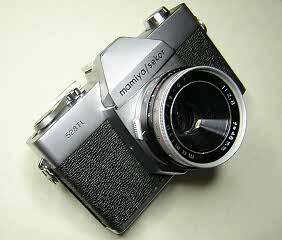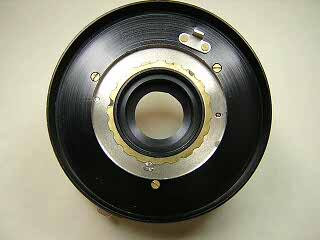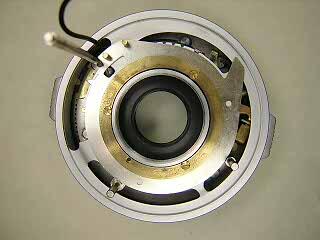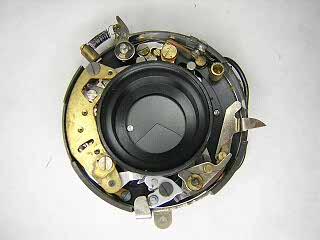Mamiya 528TL
|
The Mamiya 528TL is a fixed lens, leaf shutter SLR sold by Mamiya in the late 1960s. The lens is a simple front cell focusing triplet with maximum aperture of f/2.8. The shutter is a variant of the Copal shutter with speeds from 1/500 to 1/15 plus B with X flash synch only. The exposure control is either manual setting or shutter priority auto exposure. The body is molded plastic with plated brass top and bottom. The metering system uses a single 676 size mercury cell. The battery is only needed for operation of the auto-exposure system and meter. The camera will still function as a manual exposure camera without a battery. (Zinc-air hearing aid batteries work as a suitable replacement.) It's difficult to understand why Mamiya produced this camera. To begin with, the main advantage of an SLR is the ability to see through the lens while focusing. This allows interchangable lenses to be mounted on the camera without having to also adjust the viewfinder and focusing scale. A fixed lens SLR just doesn't make much sense. On top of that, a leaf shutter in a SLR creates special design problems. The shutter blades have to be held open in order to focus, then snapped shut before the mirror flips up. The shutter then goes through its normal cycle of open and shut. After the exposure is complete, the mirror has to return and then the shutter blades open again. All of this extended cycle of movement removes one of the big advantages of a leaf shutter. Namely, the leaf shutter is quiet and operates with very little vibration.Whatever the reason for this camera's production, it is an interesting camera because it is such an anomaly. If you are looking for a camera to take pictures with there are much better choices than this camera. For about the same price you can buy any number of good quality focal plane SLRs from the 1960s and have all the standard advantages of an SLR. As a collectable, this has very little value as well. It is, however, a tinkerer's delight. It is just complicated enough to be interesting to work on without being so complicated that it isn't worth repairing. McKeown's guide indicates that most of time this camera is found in non-working condition and of very little value. So, if you're looking for a good project, get one. You may end up with one of very few working examples of this camera. Otherwise, only the die-hard Mamiya collector will find this camera very interesting or desirable. The interesting thing about this camera from the viewpoint of us tinkerers is the way the shutter works. Overall, you have a standard mirror box mechanism and a mostly standard leaf shutter. The unique part of the shutter is a special drive ring located underneath the speed setting cam. This ring surrounds the outside of the shutter base and drives the different parts of the mechanism. Unfortunately, I don't have a a picture of this ring. One reason is that the ring sits on the shutter base under spring tension and will not stay put unless you hold it down while setting the speed cam back on. I needed a third hand to be able to take a picture! As you disassemble the shutter, look closely when you remove the speed cam and you will see this magic ring. There is a tab on the ring that pushes against a stud on the blade operating ring. When at its resting position, this tab forces the blades open. The hook attached to the main spring cam has a special cut-away that allows the blades to be pushed open while the shutter is uncocked. On the outside of the control ring there are several studs. One stud pushes against a spring operated lever to force the ring back into position at the end of the cycle. Another stud pushes on the shutter release. In addition, there is a brass lever attached to the ring that holds back the diaphragm until the just before the shutter fires. This allows full aperture focusing and metering. Study this ring closely to understand how the shutter is controled. The auto-exposure system is a fairly typical needle capture system. The meter unit is rotated by a gear driven screw. This adjusts the exposure for different shutter speed and film speed settings. Re-adjusting the meter position turned into quite an adventure. So, be sure and carefully measure the initial position of the screw that pushes the meter back and forth before disassembly. I forgot to do this and had to reset the meter position by trial and error. This camera came to me with an inoperable shutter and an stuck focus ring. Fortunately, the shutter simply needed cleaning to remove the grease on the shutter blades. However, because of the way the shutter works, you can't do a simple cleaning of the blades if they become sticky. The blades are pulled back out of the way and thus the speed setting cam and control ring have to be removed in order to get the blades to close. You can't just remove these parts because the gear that drives the meter position prevents them from being lifted off. The only way to get the gear out is to remove the mirror cage and then remove the worm screw on the other end of the gear shaft. So, it's an almost complete disassembly just to clean the shutter on this camera. As always when working on a plastic body camera, be careful about overtightening screws. It is easy to strip out the plastic thread in the screw holes of the body. |

|
 |
To remove the top cover, open the back and hold the rewind fork while unscrewing the rewind knob. Unscrew the pin-face screw over the wind lever and lift off the lever, washer, bushing and turn plate. Remove the two screws on each side of the top and the top will lift off. The shutter relase button falls out. Watch for the cable release pin located inside the shutter rlease button. There is a steel bushing around the wind shaft that lifts off. Unsolder the wire connected to the hot-shoe. Unsolder the four wires of the meter. The two CDS wires go to the yellow and green wires. The red wire comes up from the battery connector and is soldered to the blue wire. The CDS cell is located underneath the reflex mirror. The mirror itself is semi-transparent. If you look closely you can see the cell underneath the mirror. I don't know how you would replace this cell if it is bad! |
 |
To remove bottom cover, remove the two screws and lift the cover off. Unhook the spring clip holding the lever at the center of the body (red arrow) and lift the lever off the post of the mirror charging lever. |
 |
Next, pull up the leatherette on the front and remove the four screws underneath. The entire mirror box, shutter and lens will lift off together. Remove the two screws in the pentaprism bracket and lift the prism out. Look at the left side of the mirror box and study the way the meter is moved back and forth. The position of the worm screw needs to be carefully measured before removal. It is important to get the screw back in the right position before setting the meter assembly back in place. Remove the two screws holding the meter assembly and lift off the meter and circuit board. Be careful to slide the needle out from the capture plate withuot bending the needle. Remove the four screws holding the fresnel screen bracket and lift the screen out. There are two spring brackets underneath. Note, you will need to reset the focus during reassembly. Remove the two screws on the right side of the mirror box that holds the box to its bracket. Remove the screw on the left side located inside the focusing screen opening and the screw on the left bottom. There is a return spring that connects the auto-aperture lever located inside the mirror box. Unhook the spring. The mirror box can then be lifted off the front plate. Loosen the set screws on the meter positioning screw and slide the screw off. Remove the snap ring around the shaft. Unsolder the black wire at the flash connector. Remove the shutter retaining nut and the shutter will lift off the plate. |
 |
Begin working on the shutter by removing the rear lens element. If the focusing ring isn't locked in place due to dried grease, turn the focus to the infinity position. Loosen the setscrews in the focusing ring and lift the focusing ring off. Mark the infinity position of the lens and then unscrew the front lens element. Unscrew the center lens element. Remove the three brass screws and lift the DOF scale off. Underneath is the ASA ring. This ring will probably pop up as soon as the DOF scale is off due to the spring underneath on the ASA setting lever. Note how this ring drives the meter positioning gear. Pull the meter positioning gear out. Turn the lock screw one-half turn and then unscrew the serrated retaining ring. Lift off the speed setting ring. The control ring is underneath. It is attached to the shutter base with a spring. Look for the shutter click-stop button and spring. These are located in a tube mounted onto the shutter base. Remove these so they don't fall out and get lost. The retard escapement is held with two screws, one at the end on the base and the other near the pallet. Remove the flash connector. At the pallet end of the retard you will see a lever held in place with a snap ring. This is the lever that pushes the control ring down against the shutter blades to force them open. Unhook the spring, remove the snap-ring and lift the lever off. |
 |
Turn the shutter over and remove the three screws holding the aperture control. Lift off the brass ring, operating lever, spacer, and aperture control ring. Remove the three screws in the shutter base and then separate the shutter halves. |
 |
This image shows the shutter clockworks. |
Notes
There is light seal foam around the back of the mirror box. This will probably be rotten and need to be replaced. Likewise there is foam around the battery compartment.
After reassembly, you will need to reset the focus on the lens and viewer. To set the lens, turn the lens until sharp at infinity. Loosen the setscrews and turn the focusing ring against the infinity stop then tighten the screws. To set the viewscreen focus, you have to have the top cover off. Turn the four screws at the corners of the focus screen bracket until the image in the viewer matches the lens focus.
All of the mirror box mechanism is on the outside of the mirror box. On this camera there was no problem with the mirror, so I didn't do any disassembly. Study how the various levers on the mirror interact with the shutter. The wind lever and control ring points on the shutter need to be engaged with the mirror box properly during reassembly.